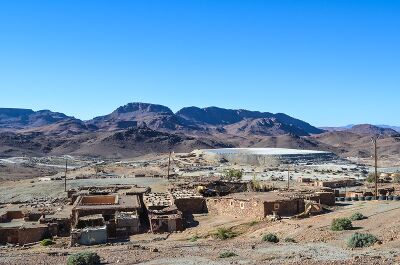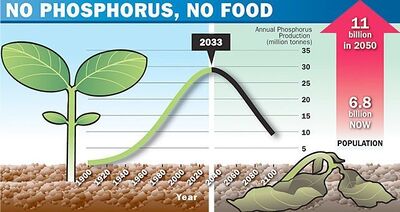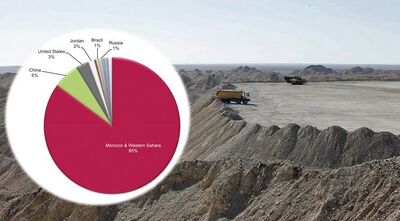Phosphorus
(raw material) | |
|---|---|
 | |
| One of the most strategic raw materials in the world. Industrial agriculture is absolutely dependent on it, but may soon be depleted. |
see also White phosphorus, a chemical weapon.
Phosphorus is a chemical element used as an industrial and commercial raw material. Phosphorus is an element essential to sustaining life largely through phosphates, compounds containing the phosphate ion, PO43−. Phosphate is needed to replace the phosphorus that plants remove from the soil, and its annual demand is rising nearly twice as fast as the growth of the human population.
Phosphate is very unevenly distributed in the soil surface. It is a finite resource, and there’s no way to manufacture it, thus making it one of the most strategic raw materials in the world. Morocco (including its occupied Western Sahara) holds 75% of the phosphate reserves of the world, and is ranked third in the world in its production.
Apart from agriculture, other applications include organophosphorus compounds in detergents, pesticides, and nerve agents.
Contents
History
Bone ash was the major source of phosphorus until the 1840s, most often from animals, but collecting bones from battlefields was a lucrative business.
In the 1840s, world phosphate production turned to the mining of tropical island deposits formed from bird and bat guano. These became an important source of phosphates for fertiliser in the latter half of the 19th century.[1] The British Empire supported proxy wars to secure guano deposits, in 1864 between Spain and Peru, and in 1879 between Bolivia, Chile and Peru; while the US took control over several dozen guano islands in the Pacific and Caribbean.
Phosphate rock, which usually contains calcium phosphate, was first used in 1850 to make phosphorus, and following the introduction of the electric arc furnace by James Burgess Readman in 1888[2][3] elemental phosphorus production switched from the bone-ash heating, to electric arc production from phosphate rock. After the depletion of world guano sources about the same time, mineral phosphates became the major source of phosphate fertiliser production. Phosphate rock production greatly increased after World War II, and remains the primary global source of phosphorus and phosphorus chemicals today.
The creation of synthetic fertilizers in the early 20th century was a turning point in human history, enabling an increase in crop yields and causing a population boom.
In the 1960s, the widespread use of synthetic fertilizer, part of the Green Revolution, allowed millions of people who would have otherwise starved to be fed by dramatically expanding the land suitable for agriculture around the world.
Morocco and Western Sahara
Western Sahara has been occupied by Morocco, just north along the coast, since 1975. If you include this disputed region, Morocco holds 75 percent of all phosphate-rock reserves in the world, according to the United States Geological Survey[4]. The next closest country, China, has just under of 6 percent. The rest is spread out in smaller pockets around the globe.[5]
The Moroccan hold over Western Sahara, a Spanish colony until 1975, is allowed by the United States because it secures this strategic resource. The illegality of the occupation is also a tool that could be used against Morocco if it ever should become disloyal.
Destabilisation of Earth’s natural nitrogen and phosphorous cycles
Before the advent of synthetic fertilisers and fossil fuels, the movement of nitrogen through the biosphere was relatively stable. In what’s known as the “nitrogen cycle,” the element’s atoms travelled through flora and fauna, being released via excretion and death back into the ground, with some escaping through bacterial conversion to the atmosphere or trickling into waterways. The nitrogen cycle was a foundation of life on Earth, helping to sustain and nourish flora and fauna alike in a harmonious balance of atomic movement.[6]
But the overuse of nitrogen and phosphorus from those fertilizers is causing an environmental crisis, as algae blooms and oceanic “dead zones” grow in scale and frequency. They are also the cause of one of the world’s least recognized, and most severe, ecological crises: the human-caused destabilization of Earth’s natural nitrogen and phosphorous cycles.[6]
That balance was shattered by industrialization and technology. While nitrogen-based fertilizers, which also contain phosphorus mined from the earth, today produce food that sustains around half of the world’s population, their liberal application has created a nitrogen “cascade.” Governments, eager to expand national economies, subsidized fertilizer purchases, allowing farmers to grow more food and faster, while chemical companies used the Haber-Bosch process to saturate the market with relatively cheap nutrients.[6]
In turn, the massive influx of nitrogen and phosphorus became a form of pollution, spilling into Earth’s ecosystems. Now, nearly 80% of the nitrogen used in synthetic fertilizer is lost into the environment through soil erosion, runoff, atmospheric conversion and other forms of waste. A 2002 study estimated that for every 100 nitrogen molecules converted by the Haber-Bosch process into fertilizer, only 14 end up consumed as food.[6]
Peak phosphorus
Peak phosphorus is a concept to describe the point in time when humanity reaches the maximum global production rate of phosphorus as an industrial and commercial raw material. The term is used in an equivalent way to the better-known term peak oil. The issue was raised as a debate on whether phosphorus shortages might be imminent around 2010, which was largely dismissed after USGS and other organizations increased world estimates on available phosphorus resources, mostly in the form of additional resources in Morocco. However, exact reserve quantities remain uncertain, as do the possible impacts of increased phosphate use on future generations.[7] This is important because rock phosphate is a key ingredient in many inorganic fertilizers. Hence, a shortage in rock phosphate (or just significant price increases) might negatively affect the world's food security.[8]
References
- ↑ Robert B. Heimann; Hans D. Lehmann (2015-03-10). Bioceramic Coatings for Medical Implants. John Wiley & Sons, 2015. p. 4.
- ↑ The Chemistry of Phosphorus, by Arthur Toy
- ↑ US patent 417943
- ↑ http://minerals.usgs.gov/minerals/pubs/commodity/phosphate_rock/mcs-2016-phosp.pdf
- ↑ https://www.theatlantic.com/science/archive/2016/11/the-desert-rock-that-feeds-the-world/508853/
- ↑ Jump up to: a b c d https://science.thewire.in/environment/nitrogen-phosphorus-crisis-industrial-agriculture-climate-change/
- ↑ https://doi.org/10.5194%2Fesd-5-491-2014
- ↑ http://www.escholarship.org/uc/item/8f42m6w4

